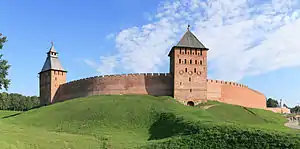
Detinets or Dytynets[note 1] is an ancient Rus' city-fort or central fortified part of a city, similar to the meaning of kremlin or citadel. The term was used in many regions, including: Kievan Rus', Chernihiv, Novgorod, and Kyiv.[1][2][3]
Old Russian manuscripts mention detinets in various places of Kievan Rus' since the end of the 11th century.[4] From the 13th to the 14th century, detinets were used only in the Russian Pskov-Novgorod region.[5]
The origin of the term is uncertain. Some derive it from the Old East Slavic word deti—"children", suggesting it was used to hide children and other less able people during a siege.[6] Polish philologist Lucyjan Malinowski derives the similarly sounding Polish term dziedziniec–"courtyard", from detinets.[7]
See also
Notes
References
- ↑ (in Ukrainian) Science-Research Institute for Monument Preservation
- ↑ A. I. (Aleksandr Ignat'evich) Semenov, Novgoroskii Kreml (Novgorod: gazeta “Novgorodskaia Pravda,” 1964).
- ↑ Manaev, Georgy (2020-05-11). "5 facts about Russia's OLDEST kremlin". www.rbth.com. Retrieved 2021-07-11.
- ↑ "Дитинець".
- ↑ Секретарь Л. А., Трояновский С. В. Детинец в градостроительной терминологии Древней Руси //Древняя Русь. Вопросы медиевистики. 2003. № 4 (14). С. 64.
- ↑ . Brockhaus and Efron Encyclopedic Dictionary (in Russian). 1906.
- ↑ Lucyjan Malinowski, "Przyczynki do historii wyrazow polskich", Polska akademia umiejętności wydział filologiczny. Rozprawy i spawozwania, vol. X, 1884, p. 454, paragraph "Dziedziniec"